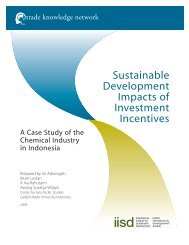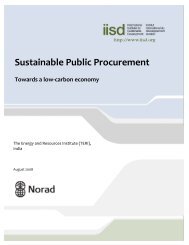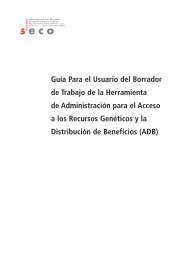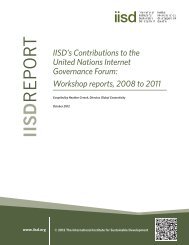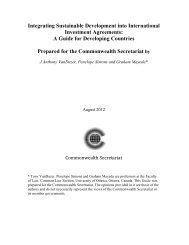Earthenterprise Tool Kit - International Institute for Sustainable ...
Earthenterprise Tool Kit - International Institute for Sustainable ...
Earthenterprise Tool Kit - International Institute for Sustainable ...
You also want an ePaper? Increase the reach of your titles
YUMPU automatically turns print PDFs into web optimized ePapers that Google loves.
EarthEnterprise <strong>Tool</strong> <strong>Kit</strong><br />
involve people from all levels of the company. Formal “green teams”are<br />
increasingly popular.<br />
• Develop a strategy that encompasses all of your company’s stakeholders.<br />
• D e m o n s t rate market leadership. Educate customers about the<br />
e nv i ro n m e n t , and make sure that internal operations are managed<br />
proactively, not in reaction to regulations. Design products and processes<br />
that incorporate environmental responsibility, and carry out cost-benefit<br />
analyses using cradle-to-grave, or cradle-to-cradle, life-cycle costing.<br />
Product Strategies<br />
• Explore all possible ways your product can be environmentally improved.<br />
Examine the relative environmental benefits of each alternative, as well as<br />
the cost and ease of implementation. Set priorities. Typically, several<br />
measures can be found that save money or are cost-neutral.<br />
• Prepare a phased plan of environmental improvements to accomplish over<br />
time. Estimate the likely timing and content of competitors’ responses and<br />
be re a dy to offer additional improvements to maintain leadership.<br />
Incorporate specific estimates of the tasks and time required to effect each<br />
planned improvement.<br />
• Ensure that your products meet or exceed the quality expectations and<br />
re q u i rements of your customers. D u ra b l e , quality products genera l l y<br />
enhance environmental per<strong>for</strong>mance.<br />
• Thoroughly test your products under consumer-use conditions.<br />
Marketing and Communications<br />
• R e s e a rch env i ronmental attitudes and purchasing criteria of yo u r<br />
customers.<br />
• Pursue alliances with other companies, environmental groups, universities,<br />
and research organizations.<br />
• Combine public relations, imaging, and other marketing/communications<br />
ef<strong>for</strong>ts with traditional advertising.<br />
• Err on the side of understatement when making environmental claims.<br />
Being conservative avoids backlash. Whenever possible, let others praise<br />
your ef<strong>for</strong>ts. Do not establish unrealistic expectations.<br />
• Communicate through sources people trust.<br />
• Treat environmentally-conscious consumers with respect. They tend to be<br />
well-educated, analytical, and cynical about corporate claims.<br />
24<br />
INTERNATIONAL INSTITUTE FOR SUSTAINABLE DEVELOPMENT




